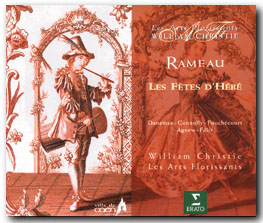Main Menu · Search ·Current Issue ·Contact ·Archives ·Centennial ·Letters to the Editor ·FAQs
As Good As It Gets |
Jean-Philippe Rameau was 50 years old before he found his calling as a composer of operas. His first, Hippolyte et Aricie (1733), is an acknowledged masterpiece and was followed, on average, by one dramatic work per year until his death in 1764. William Christie '66 found his life's work much earlier. Of listening to Hippolyte for the first time, in his senior year at the College, Christie has written, "This was, without any exaggeration, a moment when time stood still, a magical introduction to Rameau's theatrical universe." Since 1979, when he formed the groundbreaking early-music ensemble Les Arts Florissants, Christie has been devoted to the French Baroque, recording operas by Charpentier and Rameau especially, garnering five Gramophone magazine awards along the way. His latest installment, an interpretation of Rameau's opera-ballet Les F^etes d'Hébé (1739), issued last year, brought him an additional Gramophone award, in early opera, as well as his third Grammy nomination.
Rather than a single story line, opera-ballets offer a series of one-act operas, each with a different set of characters. Les F^etes begins with a prologue in which the cupbearer Hébé, disgusted with the behavior of the gods, descends from Mount Olympus and heads to the Seine, for presumably soul-healing demonstrations of "La Poésie," "La Musique," and "La Danse." These three entrées, as they're called, all start with thwarted lovers--Sappho and Alcaeus, Iphise and Tyrtaeus, and Eglea and Mercury, respectively--who, through the power of the arts, resolve their problems quickly enough for Rameau to get on with celebrating musically.
Clearly, the dramatic structure is slight--a confection that maximizes diversion and contrast rather than a traditional opera's emotional buildup. The music, too, makes few obvious claims to profundity, and many take its deceptive lightness as superficiality. During intermission at the Boston Symphony Orchestra recently, after Sir Simon Rattle's performance of a suite from another of Rameau's opera-ballets, Les Indes Galantes, a friend scoffed at the music. "Do you remember any of it?" he challenged me. "Sing one bit." Confronted like this, I'd probably stumble recalling "Happy Birthday," so I returned to the hall defeated and moody, trying to justify exactly why this apparently forgettable music had given me so much pleasure. I decided abruptly that this wasn't music that sticks to your ribs or in your memory, and that was its virtue. Think crème Chantilly, I comforted myself, not bratwurst.
Take the overture to Les F^etes. It is based on very simple gestures, an arpeggiated triad (sing the first three notes of "Michael Row the Boat Ashore") and, in the second section, a galloping, dotted rhythm on a single tone--ta-dum, ta-dum, ta-dum. While Bach would astonish us with his melodic peregrinations, Rameau uses the elements to amaze us with his sense of play. Like a musical game of hide-and-seek, the figures don't venture too far, but pop up in unlikely places. As you might expect of an opera-ballet, French dances--like musettes, gavottes, chaconnes, and tambourins--are at its core, and Rameau's contributions are as rhythmically agile as they come. He elevates charm to the highest levels of art.
These two discs are studded with great performances. Tenor Jean-Paul Fouchécourt as Mercury is appropriately fickle; as Thelemus, his nasal tones emphasize this spurned lover's whiny side. In "La Poésie," tenor Paul Agnew and soprano Sophie Daneman sing the most tender duet of the recording, "Je vous revois" ("I see you once more"), and later lend their ethereal voices to the characters of Lycurgus and Eglea. Mezzo soprano Sarah Connolly characterizes Sappho and Iphise as both regal and vulnerable. And in the role of Alcaeus, baritone Luc Coadou vows to avenge himself in a thunderous aria, "Par les horreurs du noir Tartare" ("By the horrors of black Tartarus"). In short, all of the soloists are excellent singers, but each vocal style will inevitably appeal to some listeners and not to others. The indisputable star of this album, however, is Les Arts Florissants's orchestra.
William Christie exerts complete control over the instrumentalists. Their ensemble work is near perfect; they keep the pace of the entire opera brisk; and they change emotional gears effortlessly. One of the greatest orchestral sequences comes during the second entrée, as Iphise learns of Tyrtaeus's victory over the Messenians through four allegorical dances. Each piece calls for a different instrumentation and mood--first elegiac, then sanguine, then triumphant, then all three again in quick succession. But Christie balances timbres so well that no matter what is called for, the orchestra sounds like one instrument. This performance of Les F^etes d'Hébé is clearly a product of great inspiration. In an interview published in the February issue of Gramophone, Christie pointed out a possible source. "We don't have salaried musicians in Les Arts Florissants," he said, "so when we have a programme, I know that the musicians who are playing for me are there because they want to play that music. What could be better than that?"
~ Daniel Delgado
Among other recently issued discs: Professor of music and fortepianist Robert Levin '68 joins the Academy of Ancient Music in two recordings of Mozart piano concertos (L'Oiseau Lyre 455-814-2 and 452-052-2); the Eos Orchestra, conducted by Jonathan Sheffer '75, celebrates the Gershwin centennial with music for piano and orchestra, including both rhapsodies and the "I Got Rhythm" Variations (Conifer 51342).